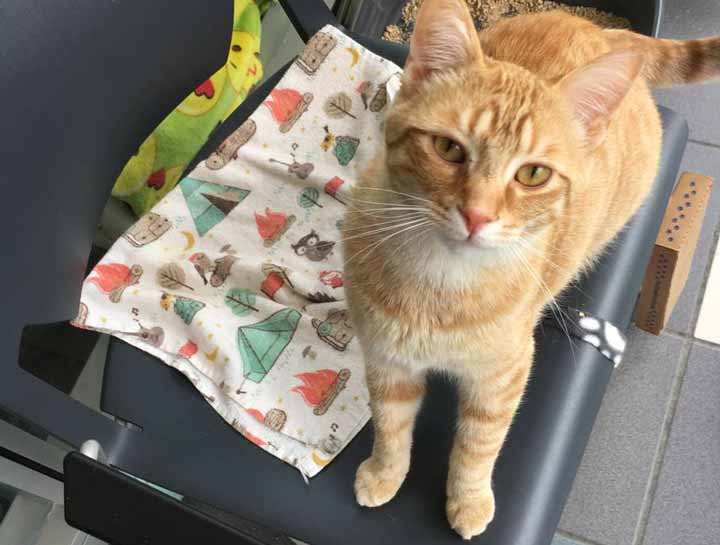Radioactive Iodine Treatment
Available Only at our Kentwood location:
Kentwood Cat Clinic
3215 Breton Road SE, Kentwood, MI
(616) 241-6369
Learn about Radioactive Iodine Treatment for Cats with Hyperthyroidism with the following owner info and instructions below.
What is hyperthyroidism?
Hyperthyroidism is the condition resulting from secretion of excess thyroid hormone. In cats, this usually results from adenomatous hyperplasia (overgrowth) or adenoma (benign tumor) of the thyroid gland. Carcinoma (cancer) is a very rare cause of hyperthyroidism in cats.
How can hyperthyroidism be treated?
Hyperthyroidism can be treated medically, surgically, or with radioactive iodine. Medical treatment consists of administration of methimazole (Tapazole) one to three times a day. Methimazole treatment will usually control the signs of hyperthyroidism, but it is not a cure. (The drug will block thyroid hormone secretion, but will not remove the thyroid tumor.) The drug must be given for the rest of the cat’s life. Surgery will cure the hyperthyroid condition and consists of the removal of part or all of the thyroid gland (the feline thyroid gland consists of two separate lobes.) Radioactive iodine (I-131 or radioiodine) will also cure the hyperthyroid condition. The procedure for this treatment is relatively simple, consisting of a single oral or injectable dose.
Why would radioiodine be used instead of medicine or surgery?
Medical therapy will work for some cats, but there can be several reasons it may not be the best choice. First, some cats are difficult or impossible to medicate. Second, mild reactions (e.g. loss of appetite, vomiting) are common, and a rare few may develop serious adverse reactions to the medication (blood, liver or skin problems). Because of these side effects, periodic blood tests are necessary to monitor the cat’s condition. Finally, some owners may not want to have to medicate their cat daily for the rest of its life.
Surgery is generally an effective treatment for hyperthyroidism but may have disadvantages in some cats. Many cats with hyperthyroidism have heart problems and are higher anesthetic risks. There is also a risk that there will be temporary damage to the adjacent parathyroid glands during thyroid surgery resulting in hypocalcemia (low blood calcium). This complication can be life-threatening and result in extra hospitalization and cost. After surgery, some cats will develop hypothyroidism and will require treatment with thyroid hormone pills for a period of time. Finally, there is a moderate risk that the hyperthyroidism will not be cured with surgery or the condition will reoccur.
Radioiodine therapy has some distinct advantages over medical or surgical treatments. With radioiodine, the need for anesthesia and the risk of hypocalcemia (the major disadvantages with surgery) are eliminated. Tapazole treatment is not needed; in fact, drug treatment must be discontinued for at least two weeks before radioactive iodine is given. The major drawback is that, after administration of radioiodine, the cat must be kept hospitalized for a period of four to five days.
How does radioiodine therapy work?
Iodine is an element that is required for normal health. In the body, it is used primarily by the thyroid gland (located in the neck) to produce the thyroid hormones. T4 and T3 are the two major thyroid hormones.
Radioiodine I-131 is a form of iodine that has been made radioactive. In its radioactive state, it undergoes a natural process (decay) in which it gives off radiation. The radiation given off consists of three types: alpha, beta, and gamma. The half-life of I-131 is eight days; in other words, one half of the radioiodine goes through this process every eight days.
When taken into the body, a large percentage of radioiodine accumulates in the thyroid gland. The remainder of the I-131 is excreted in the urine and feces. Once the radioiodine is taken up by the thyroid gland (or thyroid tumor in a hyperthyroid cat), the gamma rays and beta particles are released. The beta particles are particularly lethal to the thyroid cells. The beta particles travel a maximum of 2-5 mm in tissue; therefore, beta particles are locally destructive, but spare adjacent hypoplastic (shrunken or atrophied) thyroid tissue, parathyroid glands, and other structures in the neck. The radiation destroys the thyroid tumor cells and thus treats the hyperthyroid condition.
How is therapy given?
Your cat will receive a mild anti-emetic (anti-vomiting) medication that also relaxes the cat. In special circumstances, if we have a particularly non-compliant cat, it may receive some tranquilization to administer the radioiodine.
The radioiodine is given as a single dose on the first hospital day. After the treatment is administered, your cat is placed in a special, lead-lined radiation isolation ward, away from other animals not receiving this treatment. Your cat is then monitored over the next four to five days, until the cat’s radioactivity level is low enough to permit his or her return to you.
How long is the hospitalization period?
The half-life of the iodine used is eight days. The iodine is excreted primarily in the cat’s urine. The usual period of hospitalization is four to five days.
How do I check on my cat’s condition during treatment? Is visiting allowed?
Due to the nature of the treatment, visitation is not permitted. The cats are fed, monitored, and medicated if needed, two to three times daily by a veterinary technician and one of our doctors during their stay - we will call, text, or email you with daily updates and photos. If you wish, you can call us during our normal working hours to check on the status of your cat.
Are there side effects or risks of therapy?
Since the iodine is specific in its site of action, there is no hair loss or increase in skin pigmentation, as may be seen with other forms of radiation therapy (cobalt radiation). Some cats seem to experience mild discomfort of the thyroid region (thyroiditis) at the beginning of therapy, but this resolves itself spontaneously and does not cause a problem.
Occasionally a cat will develop hypothyroidism (underactive thyroid gland) after treatment with radioiodine. This is easily controlled with supplementation and may not be permanent. Cats with underlying kidney disease may develop more obvious signs of the kidney disease once the “masking” effects of the hyperthyroidism are removed. Overall, side effects are extremely rare.
What happens after isolation is over?
Upon discharge, your cat will still be minimally radioactive. Even though the level of radioactivity is very low (much lower than the level at which human patients are discharged from the hospital), you should still exercise caution during this period.
Your cat must be discharged in a carrier. It may not be carried or transported loose in the car on the way home. All of the remaining radioactivity in your cat will gradually disappear over the next two to four weeks (through radioactive decay and excretion into the urine and feces). Until this is complete, your cat will emit low levels of radiation. Because of this, we require that you also isolate your cat at home for one week further, two weeks if children are living in the household. This isolation can be in any spare room in your home.
Much of the residual radioactivity will be eliminated through your cat’s urine and feces. Therefore, you need to provide your cat with FLUSHABLE scoopable litter. Use plastic liners in the litter box and flush waste products daily. After changing the litter, wash your hands thoroughly. The litter MUST NOT be emptied into the garbage as it may set off radiation detectors at the landfill and may cause an investigation.
What aftercare will my cat need?
The vast majority of cats require no specific aftercare. Your veterinarian should perform a complete blood analysis and a urinalysis two and a half weeks after discharge from our hospital. Your veterinarian will also monitor the thyroid function three months after discharge and then every six months as a part of their ongoing health care plan for your pet.
Does the radioiodine treatment always work to cure the hyperthyroidism?
Our studies have shown that a single dose of radioiodine is effective in curing hyperthyroidism in over 97% of cats that are treated. Even those cats that are not completely cured after one treatment, however, show some lowering in the circulating thyroid hormone levels and improve clinically.
If hyperthyroidism persists for longer than three to six months after treatment, re-treatment with radioiodine is generally recommended to cure the disorder. Virtually all cats that remain hyperthyroid after the first treatment are cured by the second treatment.
Can the hyperthyroidism ever reoccur?
Yes, although it is very uncommon (less than 3% of cats treated). In addition, such reoccurrence usually develops three years or longer after the hyperthyroidism was first treated. Therefore, a relapse may indicate the development of a new thyroid tumor causing hyperthyroidism, rather than re-growth of the first tumor that was treated with radioiodine.
What do I do on the day of treatment?
Please bring your cat to the hospital at the scheduled time. You will need to spend about one hour at the hospital for an evaluation of your cat, an educational meeting for you, and for all paperwork to be completed. This must all be done before your cat can receive its dose of radioiodine.
You should feed your cat on the day of admission to the hospital (fasting is not necessary). Your veterinarian should have done the majority, if not all, of the tests necessary before treatment; if further tests are required, they can be performed by us, but the treatment may then have to be postponed. If your cat has been on methimazole (Tapazole/Felimazole) or the Hill's y/d prescription diet, these treatments must be discontinued for at least two weeks prior to treatment with radioiodine.
Should I bring anything for my cat?
We ask that you bring several cans and a bag of dry food that your cat is used to eating (a Ziploc bag is fine—enough for the four to five days of hospitalization) so that we have exactly what you want your cat to eat during the time of hospitalization. Personal items (a sock or toy) to place in your cat’s cage are allowed, but will not be going back home with the cat due to potential radiation contamination, so make sure it is an item you and your cat are not strongly attached to.
What happens on the day of admission?
Dr. Keir or Dr. Verwys will give you a full explanation of hyperthyroidism and I-131 treatment will be reviewed with you. If all of the other routine blood tests, urine and x-rays have been done by your veterinarian, we will treat your cat on the day of admission.
Is radioiodine therapy expensive?
The cost of any treatment for feline hyperthyroidism is significant. The total fee for radioiodine therapy is generally $1900*, but may be more if the hyperthyroidism is severe. This includes the radioiodine itself, the cost of hospitalization and monitoring, and for licensed technicians to care for the cat’s daily food, water, and litter needs. Tests required prior to therapy are not included. This compares reasonably with most fees for surgical removal. The cost of medication would average $400-500 per year, plus the cost of repeat blood tests.
Please note: because we must order the dose of radioiodine before the treatment is administered, cancellation of a scheduled appointment (less than 3 business days before the scheduled appointment time) will result in a charge of $300*
(*Prices are subject to change, contact us for the most up-to-date prices)
How do I pay for radioiodine therapy?
Payment will be made at time of service. We accept cash, checks or charge cards: Visa, MasterCard, Discover, American Express, Care Credit or Scratch Pay.

